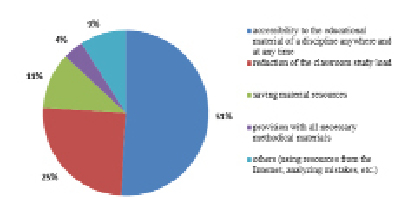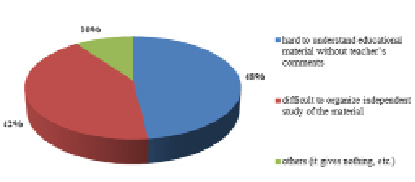MOODLE – the abbreviation of the phrase “Modular Object-Oriented Dynamic Learning Environment”, is an automated, computer-based and Internet-based learning management system. The first version of MOODLE 1.0 was developed by Martin Dougiamas, the professor of Part University (Australia), and put into operation in August 2002. Nowadays, there are a significant number of platforms for the organization of e-learning and control in the world. Initially, they appeared in the USA, and in the last decade are actively developed and implemented in Kazakhstan. According to research, the leader is the MOODLE system [3, 4]. The latest version of MOODLE is MOODLE 2.3 at the moment. Despite the fact that the MOODLE system was originally oriented towards university education, it was subsequently successfully used to organize both pre-university (school) and postgraduate (corporate) education.
Relevance: Currently, there are more than 60,000 registered installations of the MOODLE platform in 201 countries worldwide, it has been translated into 78 languages. About 2 million teachers around the world use MOODLE to train more than 26 million students. Through this system, about 2.5 million courses are being taught today using almost 20 million electronic resources. MOODLE is a web-based application located on the server, and is accessed through a browser. The server is usually located in a university or faculty building, but it can be located anywhere else. At its core, MOODLE gives the teacher the opportunity to create a course website and manage access to it so that only enrolled students can view it. In addition to access control, MOODLE provides a wide range of tools that will make the training course more effective. The system implements the philosophy of pedagogy of social constructionism developed by Martin Dougiamas, which is primarily aimed at organizing interaction between the teacher and students, although it is also suitable for organizing traditional distance courses, as well as supporting full-time education. The test system MOODLE allows you to create banks of test tasks of all the basic forms and build tests that are designed for self-control and training, thematic tests, tests for current and final assessment of the level of trainees, etc. [5, p.17; 6, p.109]. Thus, MOODLE can be effectively used for both current control, and in more traditional situations: testing, creating hypertext materials, etc. Full use of this training management system makes it possible to ensure: multivariate presentation of information; interactive learning; revision of the studied material; structuring of content and its modularity; creation of constantly active help system; self-control of training activities; alignment of individual educational trajectories; confidentiality of training; compliance with the principles of successful learning.
In this paper, we will try to present the possibility of using the MOODLE training management system to organize and conduct current monitoring of the development of grammar skills in English teaching.
The objects of current monitoring in English teaching to students at the Faculty of continuous professional development are the adequacy and reliability of concepts regarding the meaning, form and use of specific grammatical phenomena to be learned, and the level of developed grammatical actions and operations themselves, which can be checked with the use of control exercises and test items. Despite the fact that the main subject of control must be speaking skills, which testify to the ability to participate in communication, the most important role, in our opinion, belongs to grammar language skills on the development of which speech activities are based.
Organization of the educational process using MOODLE has a number of features. MOODLE has an automated test system that allows the teacher to form test banks and build test items out of them. An important feature of this system is that the test items can be diverse; their solving requires students’ knowledge of grammatical material and creativity, as students are involved in active cognitive activity connected to the comprehension and revision of educational material, putting knowledge into practice during solving problems.
Let us consider the features of the organization and conducting of the current monitoring with the use of the training management system MOODLE on the example of studying the grammatical theme “Conditional sentences”. Acquaintance with this grammatical material takes place at the lesson where students first independently read the rules with examples, and then a joint and detailed discussion of the read rules is carried out. Next, the group starts working with training exercises in order to consolidate this grammatical material. One part of the exercises is done at the lesson, and another one is the homework. After acquainting and consolidating this grammatical phenomenon, the main task of the teacher is to control the mastery of this grammatical theme. At the organization stage, the teacher develops and prepares tests. When working in the MOODLE environment, the teacher is provided with a very wide range of tools. One of the main possibilities giving to the teacher by the Moodle system is the creation of the course (module): adding, removing, moving resources, blocks. The module-test allows the teacher to create a set of test items. Test items can be with: multiple choice answers, one correct answer, the choice of “true” / “false”, a short text answer, a numerical answer; they can be matching questions, questions with answers in the gaps, a calculated question, and others, not included into the standard framework.
Students can receive feedback on the completed test and / or the correct answers. Questions are entered manually by the teacher through the interface in MOODLE or can be imported in various formats. Students start working with self-control test. In our opinion, self-control tests are a useful and necessary link, as students have the opportunity to revise the grammatical material and pay attention to the mistakes done during testing. Such tests are an integral part of the independent work of students due to the presence of a key. At the same time they activate mental operations, develop memory, attention.
All questions are stored in a database by categories and can be subsequently used again in the same course (or in others). To the test, random items from a certain category can be added, where random test items from a given category will be substituted for each test attempt. Test items and answers to them can be shuffled (randomly) to limit opportunities for cheating. Test items can contain HTML and images. Due to the combination of various parameters, it is possible to create training tests. The test results may show the correct answers or just a mark. After the tests for self-control have been successfully done, the mistakes have been analyzed, the students start performing evaluation tests, which can have different types, as the MOODLE system allows to organize and conduct control quite versatile and interesting.
The aim of the research: to evaluate the use of the “MOODLE” system in English language training at KSMU
Tasks:
1. to develop a questionnaire on the effectiveness of using the MOODLE platform among students and teachers of KSMU.
2. to conduct questioning among students and teachers of KSMU, which allows to determine the use of the MOODLE system.
3. to develop recommendations for optimizing and improving English language teaching on the MOODLE platform.
Materials and methods: a survey of first-, second-, fourth-year students, as well as master’s-program students of KSMU has been conducted.
Methods of research:
1. Sociological research method (questionnaire).
2. Statistical methods for processing research data with the use of computer programs (Microsoft Excel).
Results. At the Department of Foreign Languages of KSMU, a survey was conducted among first-, second-, fourth-year students, as well as master’s-program students, total – 100 students, in order to assess the use of the MOODLE training management system. The greatest number of respondents was fourth-year students – 66 %, 20 % – first-year students, 8 % – master’s-program students, 6 % – second-year students. The results obtained were analyzed and systematized.
The following aspects were considered by the respondents as advantages of the MOODLE system:
– accessibility to the educational material of a discipline anywhere and at any time – 51 %;
– reduction of the classroom study load – 25 %;
– saving material resources – 11 %;
– provision with all necessary methodical materials – 4 % (fig. 1).
The difficulties with which students were faced when working with MOODLE are:
– it is hard to understand educational material without teacher’s comments – 48 %;
– it is difficult to organize independent study of the material – 42 % (fig. 2).
Comments, suggestions and additions were made to use the MOODLE platform in the educational process:
– to develop methodical recommendations for using the MOODLE platform;
– to increase the time for testing because of the system hang;
– to reduce the workload of the MOODLE platform.
Conclusions
The MOODLE system is used for organization and conduction of the current control of acquisition of students’ knowledge and skills in teaching English language at the Department of Foreign Languages of KSMU. This system, in our opinion, allows conducting control most effectively.

Fig. 1. The main advantages of Moodle are

Fig. 2. The main dysadvantages of Moodle are
Summarizing, it is important to note the effectiveness of using the MOODLE training management system to organize and monitor the development of grammatical skills, because such organization of the control process makes it more objective, effective and has a number of the following advantages over traditional control methods: it allows more efficient organization of the educational process as a whole and student’s independent work in particular; provides an opportunity to interest students through the introduction of new technologies and forms of training process. Thus, based on the results of the questionnaire to improve the efficiency of the MOODLE platform, it is possible to recommend: to develop methodical recommendations for using the MOODLE platform; to add a course of listening, video lectures, and to implement a MOODLE mobile application for teaching English.
In conclusion, we would like to express gratitude to our scientific advisor – the Head of Foreign Languages Department, c.p.s., associate professor V.A. Burmistrova.

